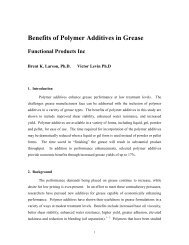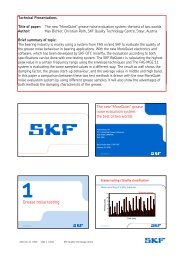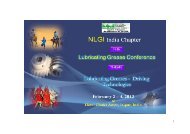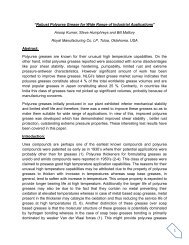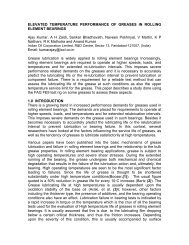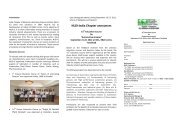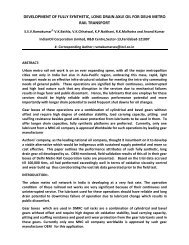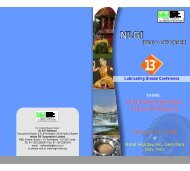Molybdenum Disulfide in Greases - A Review - (NLGI) - India Chapter
Molybdenum Disulfide in Greases - A Review - (NLGI) - India Chapter
Molybdenum Disulfide in Greases - A Review - (NLGI) - India Chapter
You also want an ePaper? Increase the reach of your titles
YUMPU automatically turns print PDFs into web optimized ePapers that Google loves.
Res<strong>in</strong>-bonded lubricant coat<strong>in</strong>gs are perhaps the most common product for achiev<strong>in</strong>g adry, self-lubricat<strong>in</strong>g film on metal surfaces. A res<strong>in</strong>-bonded lubricant coat<strong>in</strong>g has beendef<strong>in</strong>ed as a solid lubricant dispersed <strong>in</strong> a cont<strong>in</strong>uous matrix of a b<strong>in</strong>der (<strong>in</strong>organic or organic)and attached to a surface 20 . Many different compositions are commercially available withdifferent b<strong>in</strong>der and additives.A typical formulation is composed of MoS 2, which could be up to 80%, and/or otherlubricat<strong>in</strong>g solids, additives, a b<strong>in</strong>der (organic or <strong>in</strong>organic) and a carrier liquid. Organicres<strong>in</strong>s may <strong>in</strong>clude acrylic, phenolic, epoxy, amide-imide, urethane and polyimide. Newerorganic res<strong>in</strong>s <strong>in</strong>clude polybenzimidazole, and polybenzothiozole. Many newer formulationsconta<strong>in</strong> water-borne res<strong>in</strong>s that are more environmentally friendly (lower VOCs) rather thansolvent based res<strong>in</strong>s. Some products require a heat cur<strong>in</strong>g cycle, while others are ready to useafter dry<strong>in</strong>g at room temperature. Bonded lubricant coat<strong>in</strong>gs can be applied by severalmethods used <strong>in</strong> apply<strong>in</strong>g pa<strong>in</strong>t-like coat<strong>in</strong>gs. These <strong>in</strong>clude conventional spray<strong>in</strong>g,electrostatic spray<strong>in</strong>g, roll-coat<strong>in</strong>g, and dip-coat<strong>in</strong>g/centrifug<strong>in</strong>g, Coat<strong>in</strong>g thickness anduniformity is critical to optimum performance; typical thickness ranges from 8 µm to 18 µm.Some res<strong>in</strong>-bonded coat<strong>in</strong>gs are oil compatible, and are able to provide friction and wearreduction under boundary lubrication conditions. One example is an automotive piston skirtcoat<strong>in</strong>g which improves fuel economy and extends eng<strong>in</strong>e durability 21 . Another applicationfor bonded lubricant coat<strong>in</strong>gs is fasteners. In threaded connections, the uniform coefficient offriction provided by the bonded coat<strong>in</strong>g m<strong>in</strong>imizes the possibility of exceed<strong>in</strong>g the yieldstrength of the bolt due to erratic friction dur<strong>in</strong>g tighten<strong>in</strong>g 22 .A variety of MoS 2 particle sizes may be used for bonded coat<strong>in</strong>g applications depend<strong>in</strong>gon the specific formulation. For <strong>in</strong>stance, if the product is <strong>in</strong> aerosol form, the smallestavailable particles may be required to guard aga<strong>in</strong>st spray tip clogg<strong>in</strong>g.SummaryThe molybdenum disulfide used <strong>in</strong> lubricant applications is the purified form of the m<strong>in</strong>eralMolybdenite. The commercial form of lubricant grade of MoS 2 possesses a hexagonal layerlattice crystal structure which gives it low friction and excellent adherence to most metals. Asa solid lubricant, the excellent lubricant properties of MoS 2 are attributable to the large10



